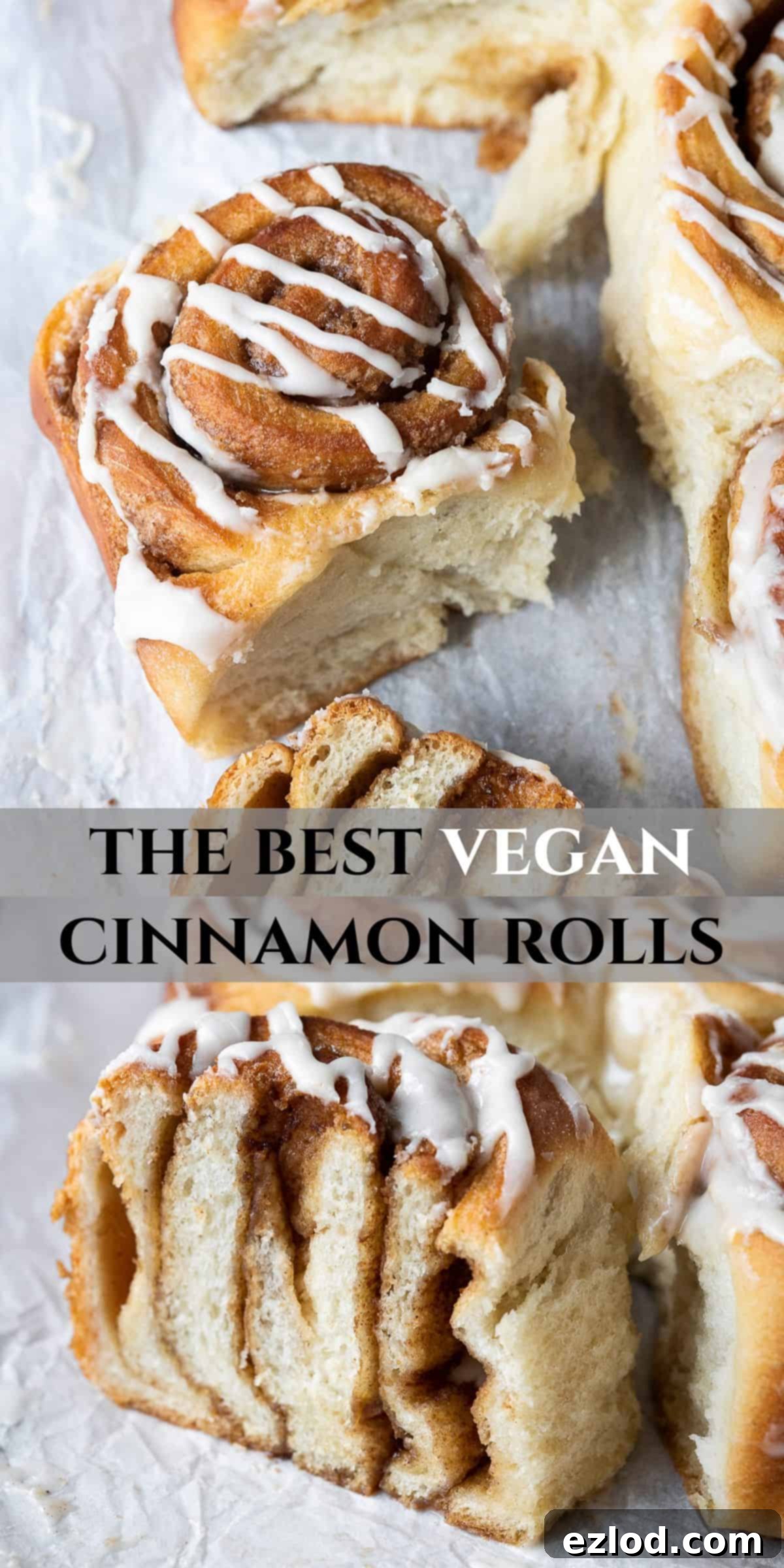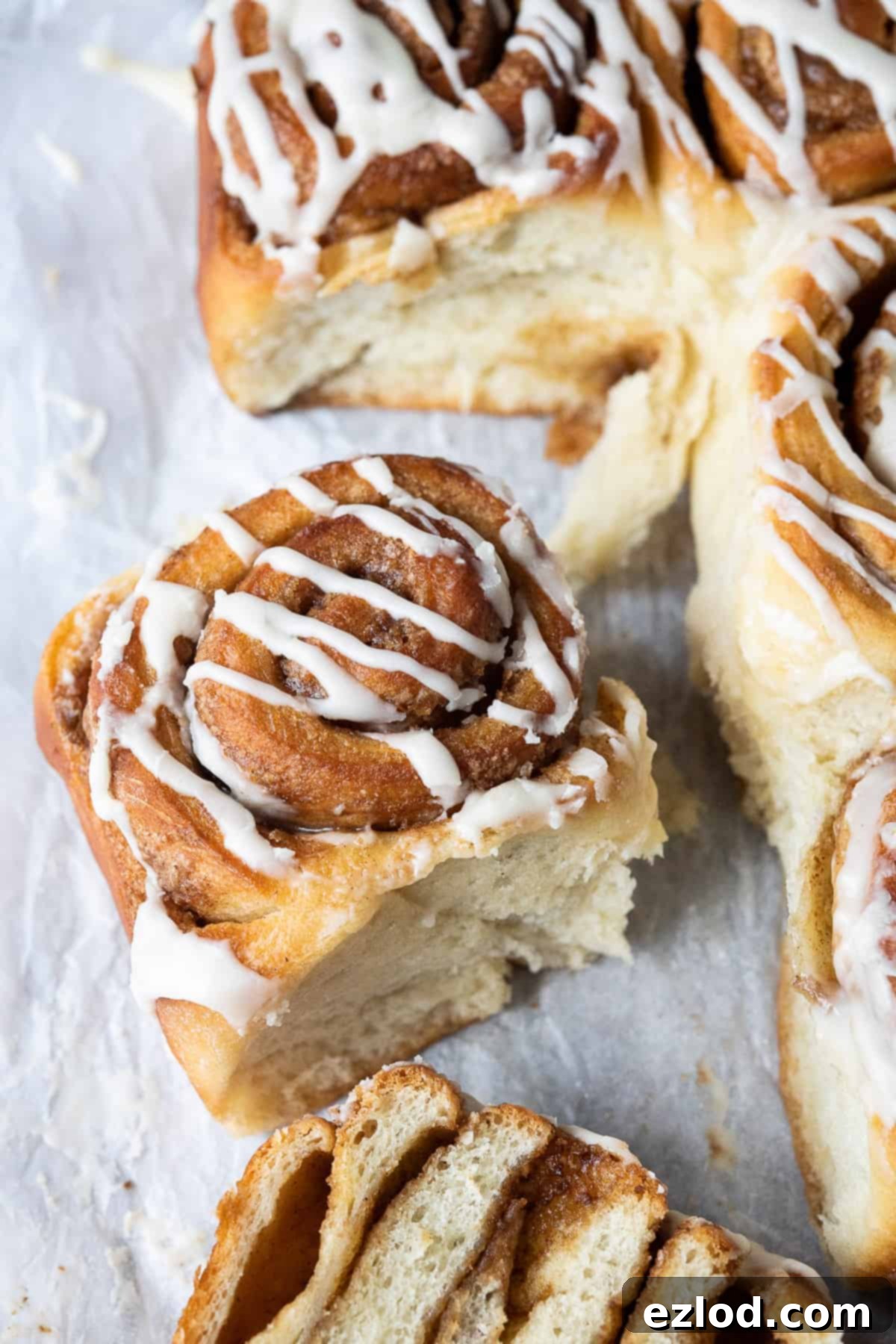The Ultimate Soft & Fluffy Vegan Cinnamon Rolls: Tangzhong Method Revealed
Discover how to make the most incredibly soft, fluffy, and moreish vegan cinnamon rolls using the secret Tangzhong method. These eggless and dairy-free delights are perfect for breakfast, dessert, or any time you crave a sweet, comforting treat.
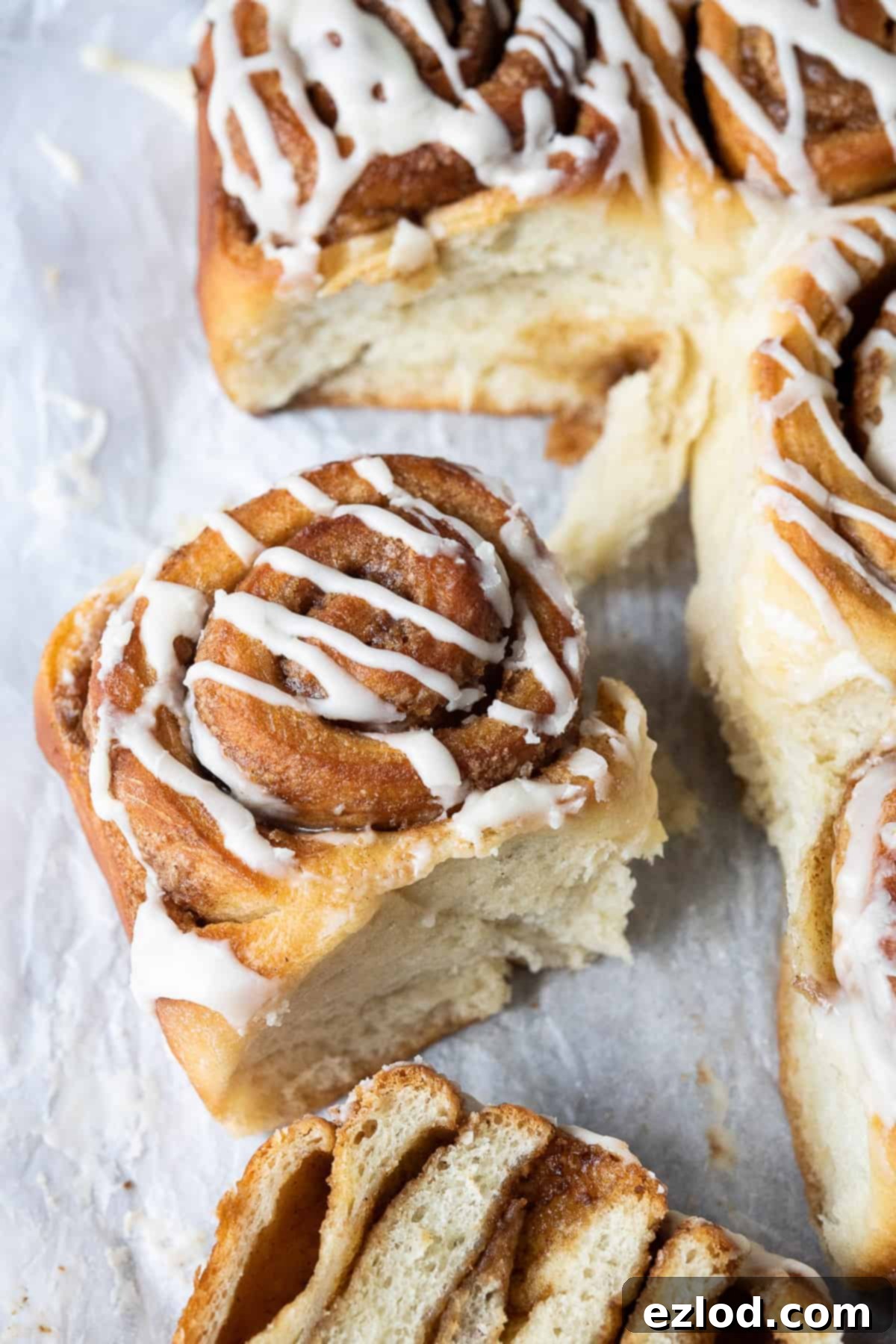
It recently dawned on me that while my blog features several exciting variations of vegan cinnamon rolls, the cornerstone—a recipe for classic, basic vegan cinnamon rolls—was noticeably absent! Today, that changes. Prepare yourself for the softest, squishiest, and most unbelievably delicious vegan cinnamon rolls you’ll ever bake, meticulously crafted to perfection.
The secret to their unparalleled texture lies in the ingenious Tangzhong method. If you’re unfamiliar with this technique, don’t fret; it’s far simpler than it sounds and promises to revolutionize your baking. It involves cooking a small portion of flour and milk into a “roux” before incorporating it into the main dough. This simple step is a game-changer, resulting in rolls that are supremely moist and stay fresh for longer.
This very method is behind the success of my widely adored vegan Hokkaido milk bread, a recipe that has won over countless bakers. If you’ve loved those results, you’re in for an even greater treat with these cinnamon rolls. They are completely eggless and dairy-free, making them accessible to a wider audience without compromising on taste or texture. Get ready to experience vegan baking at its finest!
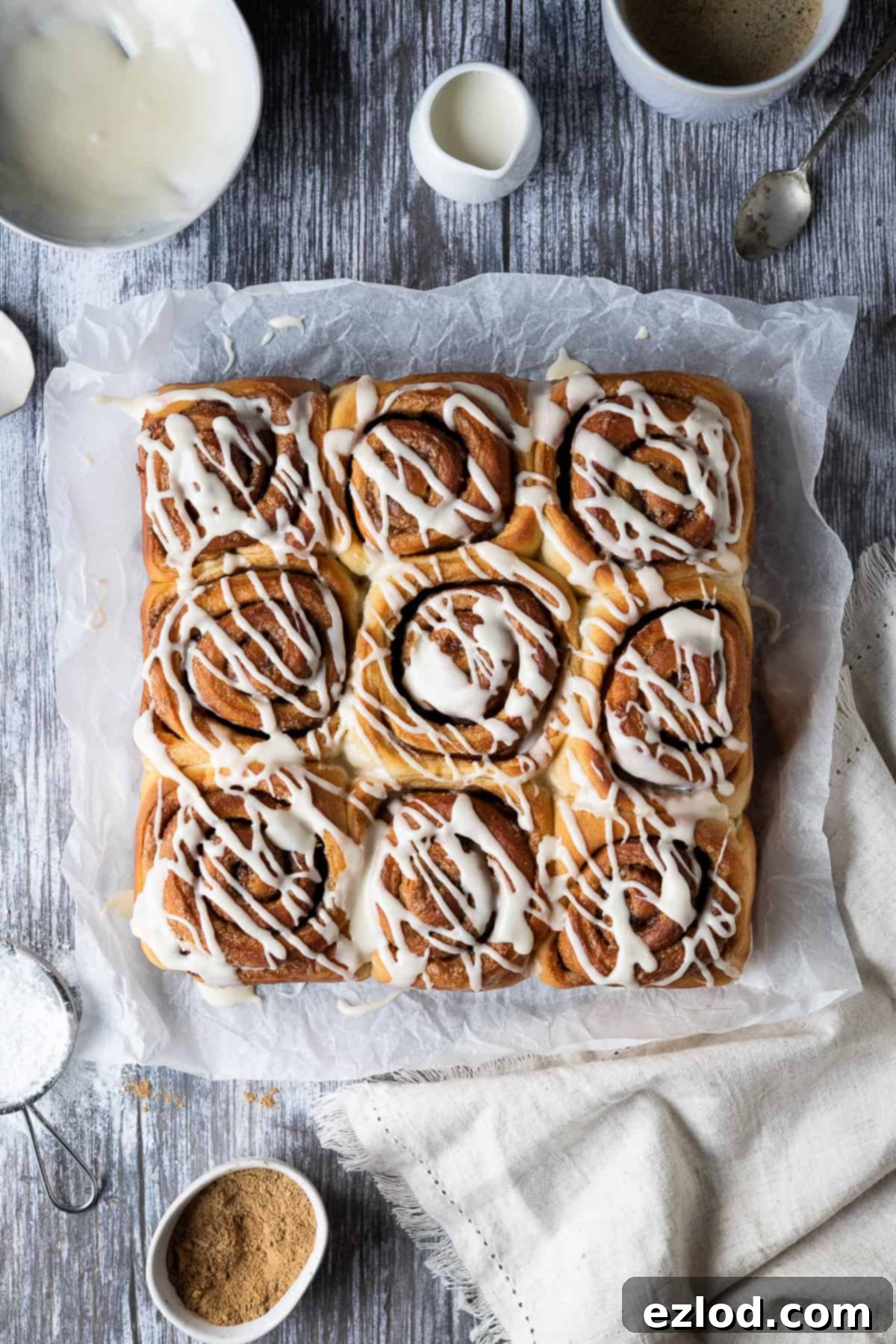
What Exactly Is The Tangzhong Method?
Tangzhong, a technique originating from Asian baking, specifically Japanese milk bread, is a water-roux paste that significantly enhances the texture and shelf life of baked goods. It involves pre-cooking a small portion of the flour and liquid (typically water or milk) from your recipe. You combine them and gently cook them over low to medium heat, whisking constantly until the mixture transforms into a thick, pudding-like consistency. This seemingly small step has a profound impact on the final product.
The magic of Tangzhong lies in its ability to gelatinize the starches in the flour. When starches are heated in the presence of liquid, they absorb moisture and swell. By pre-gelatinizing a portion of the flour, it allows it to absorb a greater amount of liquid—in fact, flour can absorb up to twice as much hot water or milk compared to lukewarm liquid typically used in yeast doughs. This increased absorption means more moisture is locked into the dough.
What does this mean for your vegan cinnamon rolls? First, the bread will rise higher. The extra absorbed liquid turns into steam during baking, contributing to a more significant oven spring alongside the carbon dioxide produced by the yeast. Second, because the dough retains more water throughout the kneading, baking, and cooling processes, the resulting rolls are incredibly soft, moist, and delightfully fluffy. This enhanced moisture content also plays a crucial role in extending their freshness, keeping them soft and delicious for several days, a notable advantage over traditional cinnamon roll recipes.
Essential Ingredients for Your Vegan Cinnamon Rolls
Creating these heavenly vegan cinnamon rolls requires a selection of quality ingredients. Here’s a breakdown of what you’ll need and why each component is important:
- Bread Flour: This is my top recommendation for achieving the ideal soft, fluffy, and slightly chewy texture. Bread flour has a higher protein content than all-purpose flour, which helps develop stronger gluten for a better rise and structure. While plain (all-purpose) flour can be used, the texture won’t be quite as remarkable. I strongly advise against using wholemeal (whole wheat) flour, as it will make the rolls too dense and heavy.
- Instant Yeast: For convenience and consistent results, instant yeast is my go-to choice. It can be mixed directly with the dry ingredients without needing prior activation in liquid. If active dry yeast is all you have, don’t worry—I’ve provided specific instructions below on how to activate it before adding it to your dough.
- Salt: A non-negotiable ingredient in bread baking, salt is vital for flavor balance and controlling yeast activity. Never omit it; even in sweet recipes, a pinch of salt enhances all the other flavors.
- Sugar: I use caster sugar in the dough to provide sweetness and aid yeast activity, and light brown soft sugar in the filling for its rich, caramel-like notes. Caster sugar can be substituted with granulated sugar if needed. For a deeper molasses flavor in the filling, feel free to use dark brown sugar instead of light.
- Vegan Block Butter: For superior baking results, especially in recipes requiring specific textures, I always opt for a solid vegan block butter or margarine. These typically have a lower water content compared to spreadable margarines found in tubs, which can sometimes lead to less consistent outcomes. My personal favorite is Naturli Vegan Block for its excellent performance. However, if spreadable vegan butter is all you have, it will work, just be mindful of its softer consistency.
- Non-Dairy Milk: Soy milk is my preferred non-dairy milk for baking due to its higher protein content, which closely mimics the properties of dairy milk and contributes to a rich, tender crumb. Any unsweetened variety of non-dairy milk will work, but if you have soy milk available, it’s highly recommended for the best results.
- Cornflour (Cornstarch): A little cornflour added to the cinnamon sugar filling acts as a binder, preventing the delicious mixture from oozing out of the rolls during baking. If you don’t have cornflour, plain (all-purpose) flour can be used as an alternative.
- Ground Cinnamon: This is a cinnamon roll recipe, so ground cinnamon is an absolute must! Ensure your cinnamon is fresh for the most vibrant flavor.
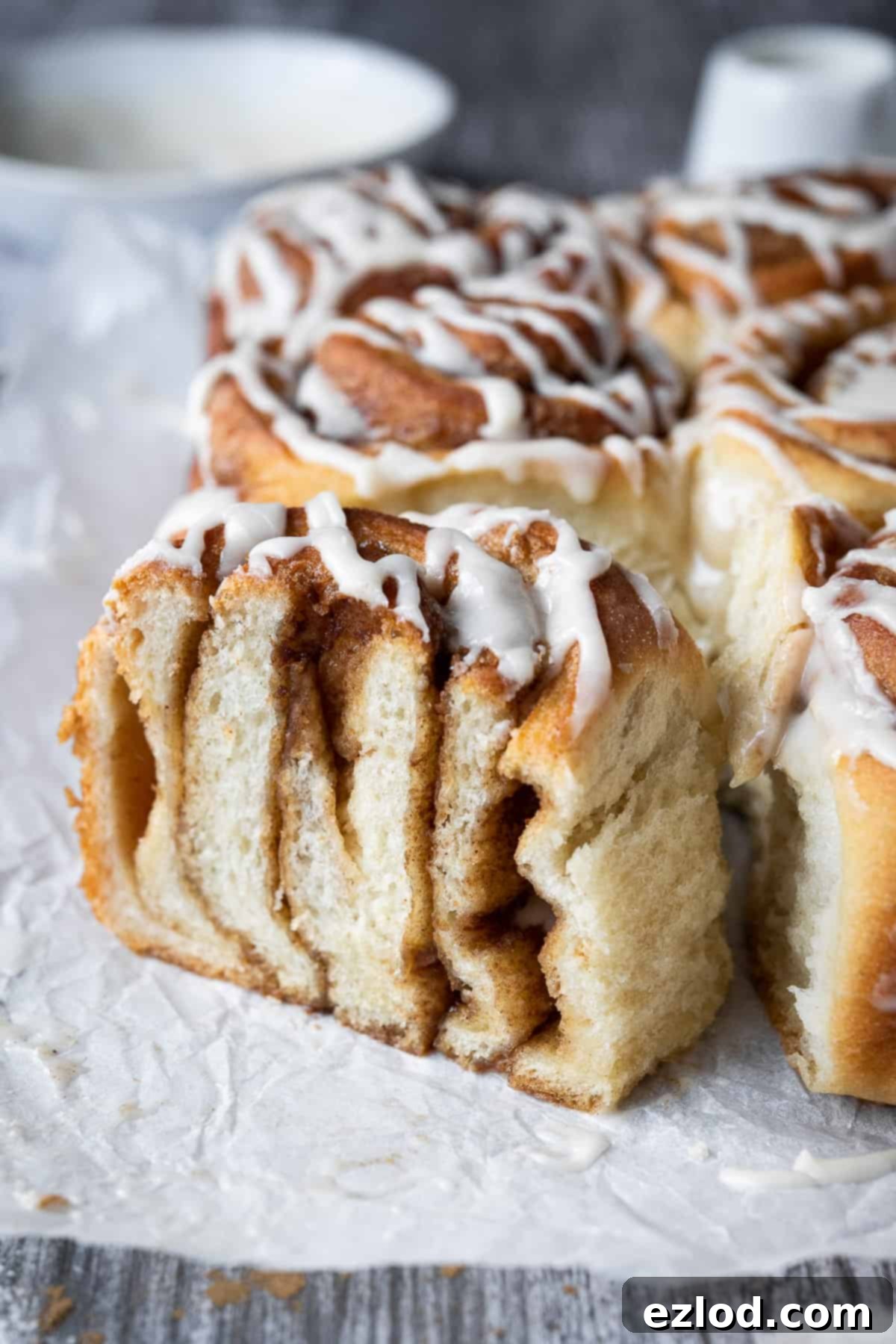
How To Craft The Perfect Vegan Cinnamon Rolls
Making these vegan cinnamon rolls is a delightful process, and for optimal flavor and ease, I often recommend splitting the work over two days. This allows for a slow, overnight rise in the fridge, which not only develops a richer flavor but also makes the dough much easier to handle when it’s time to roll it out. However, if you’re short on time, you can certainly complete the entire recipe in one day.
Preparing the Tangzhong:
- Begin by making the Tangzhong. In a small saucepan, combine the bread flour. Gradually whisk in the unsweetened non-dairy milk until no lumps remain and the mixture is smooth.
- Place the pan over a medium-low heat. Whisk continuously as the mixture heats up. It will start to thicken, eventually forming a paste-like, pudding consistency (similar to wallpaper paste). This process usually takes only a few minutes.
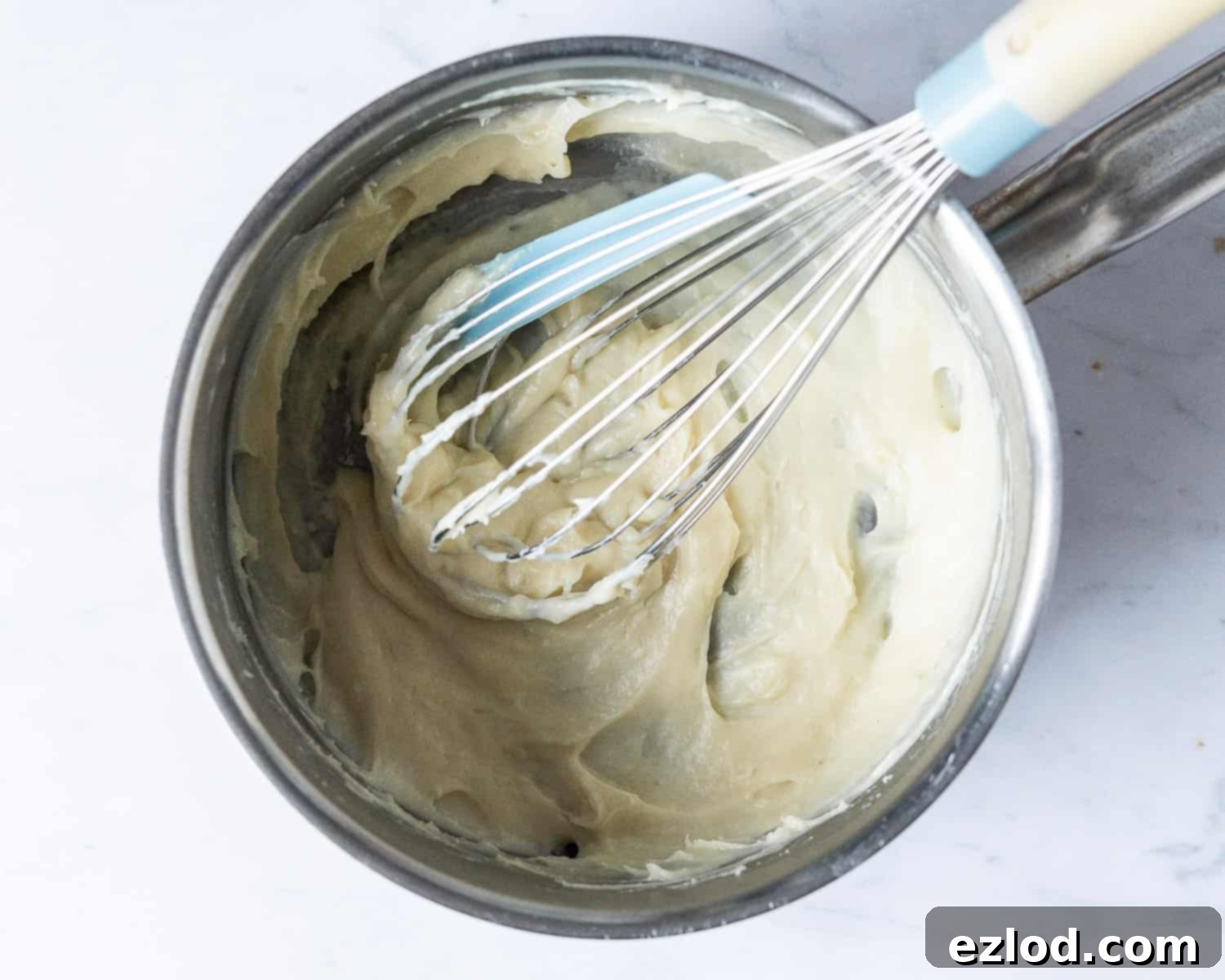
Making the Dough:
- Once your Tangzhong is ready, immediately scrape it into the bowl of a stand mixer fitted with a dough hook. Pour the remaining cold non-dairy milk over the Tangzhong. The cold milk helps to cool down the hot Tangzhong quickly, ensuring it won’t harm the yeast.
- Add the sugar, salt, and the rest of the bread flour to the mixer bowl, followed by the instant yeast.
- Stir briefly until a rough dough forms. Then, set the stand mixer to a medium speed and knead the dough for approximately 10 minutes, or until it becomes smooth, elastic, and stretchy.
- Next, add the softened vegan block butter. Continue kneading for another 5 minutes until the butter is fully incorporated into the dough. The dough should be smooth, elastic, and no longer feel greasy. You might need to pause and scrape down the sides of the bowl a couple of times during this step.
- The dough should remain soft and slightly sticky, yet it should pull cleanly away from the sides of the bowl. If it appears excessively wet, you can add a small amount of extra flour, one tablespoon at a time, but exercise caution. This is intended to be a soft dough; adding too much flour will result in dry, dense cinnamon rolls.
- Lightly oil a large bowl, place the dough inside, cover it securely with plastic wrap or a damp cloth, and refrigerate it overnight for its first rise. Alternatively, for a same-day bake, place it in a warm spot for 1-2 hours until it has doubled in size.
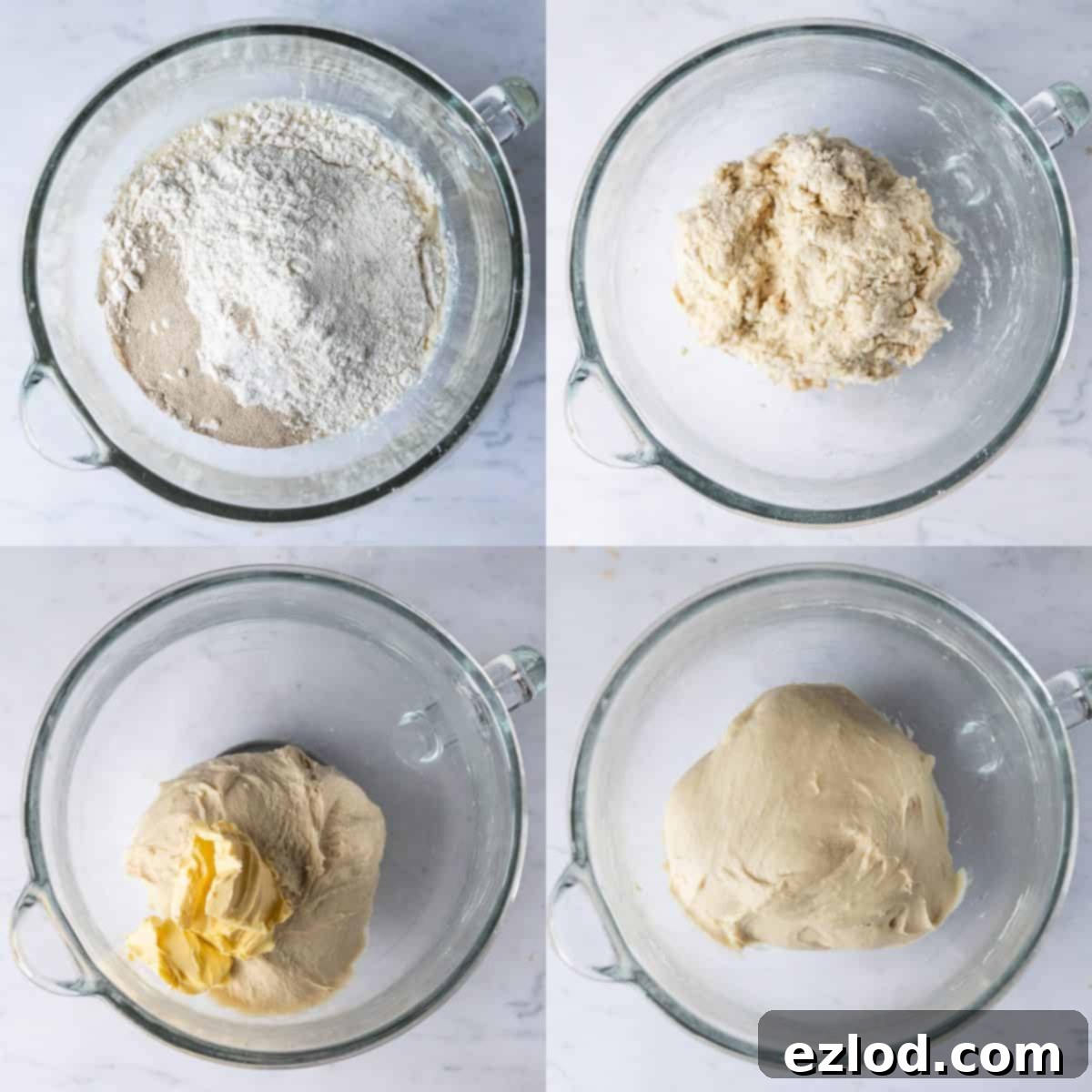
Preparing the Filling:
- For the rich cinnamon filling, combine the light brown soft sugar, ground cinnamon, cornflour (cornstarch), and a pinch of salt in a small bowl. Mix thoroughly and set aside.
Shaping the Cinnamon Rolls:
- On the second day (or once your dough has doubled in size), gently punch down the dough to release the air. Give it a brief 30-second knead to ensure all large air bubbles are expelled.
- Lightly flour your work surface and roll the dough into a rectangle, approximately 30 x 45 cm (12 x 18 inches). Aim for a neat rectangular shape to ensure evenly sized cinnamon rolls.
- Spread a generous layer of very soft vegan butter evenly over the dough, leaving a small 1cm border around the edges. It’s crucial that the butter is very soft (but not melted) to spread easily without tearing the dough. I often use my hands for this step.
- Evenly scatter the prepared cinnamon sugar mixture over the buttered dough. Gently press the sugar mixture down with your hands or a rolling pin to ensure it adheres.
- Starting from one of the long sides, carefully roll the dough into a tight sausage.
- For clean cuts, use unflavored dental floss: slide a piece under the dough where you want to cut, cross the ends over the top, and pull. Alternatively, use a very sharp knife. Slice the roll into 9 equally sized pieces (for larger rolls) or 12 pieces (for smaller rolls).
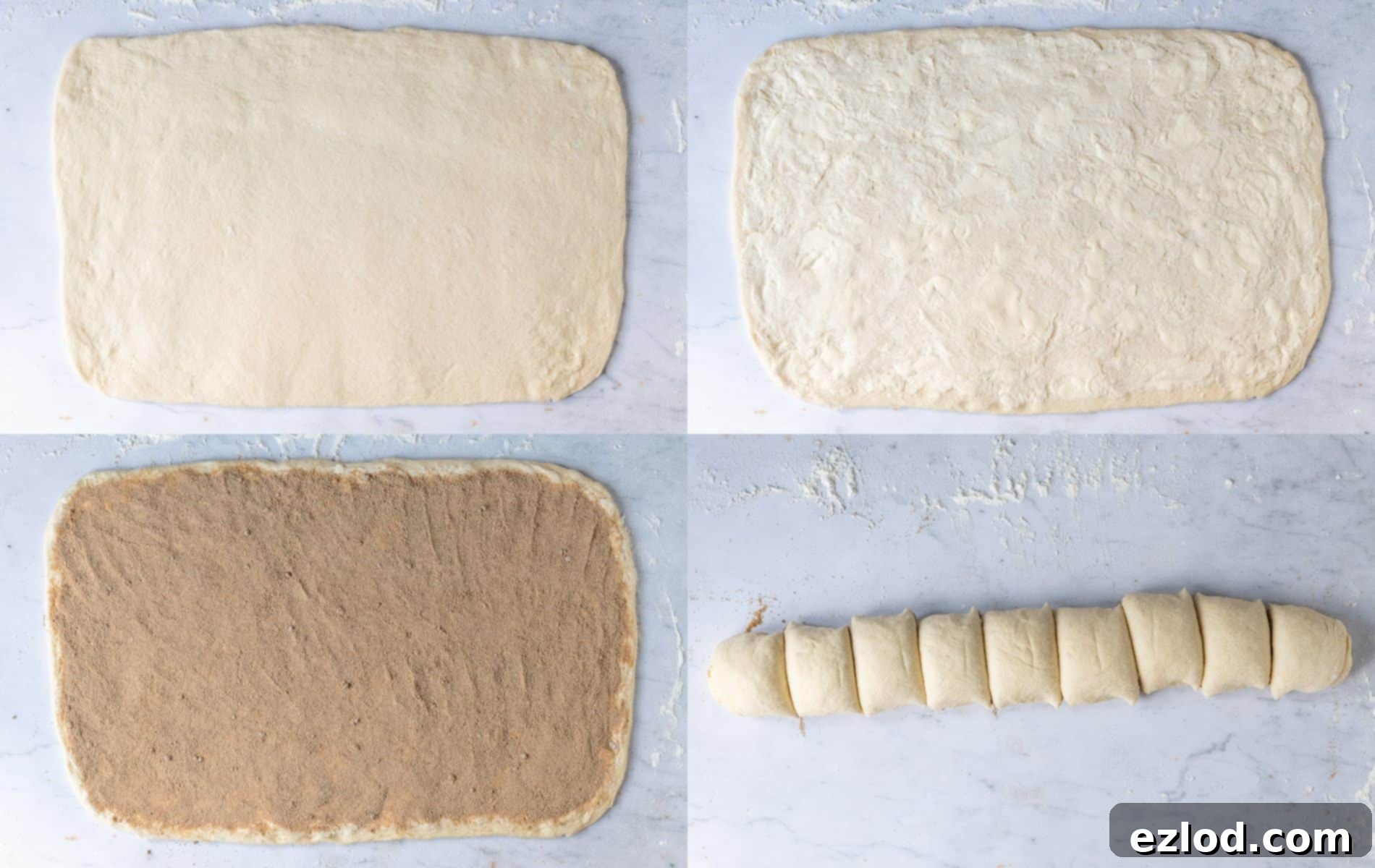
Second Rise and Baking:
- Arrange the sliced cinnamon rolls in a 23cm (9-inch) square cake tin lined with baking parchment (or a 20 x 30 cm / 8 x 12 inch rectangular tin for 12 rolls).
- Loosely cover the tin and allow the rolls to rise in a warm spot for 45-60 minutes, until they are noticeably puffy. To check if they are ready, gently press one roll; the dough should spring back slowly. If it springs back quickly, they need a little more time. Preheat your oven to 180°C/160°C fan/350°F/gas mark 4 during this time.
- Bake for 30-35 minutes (or 20-25 minutes if making 12 smaller rolls), until the internal temperature reaches 90°C/194°F with a probe thermometer. If the tops begin to brown too quickly, loosely tent the pan with aluminum foil.
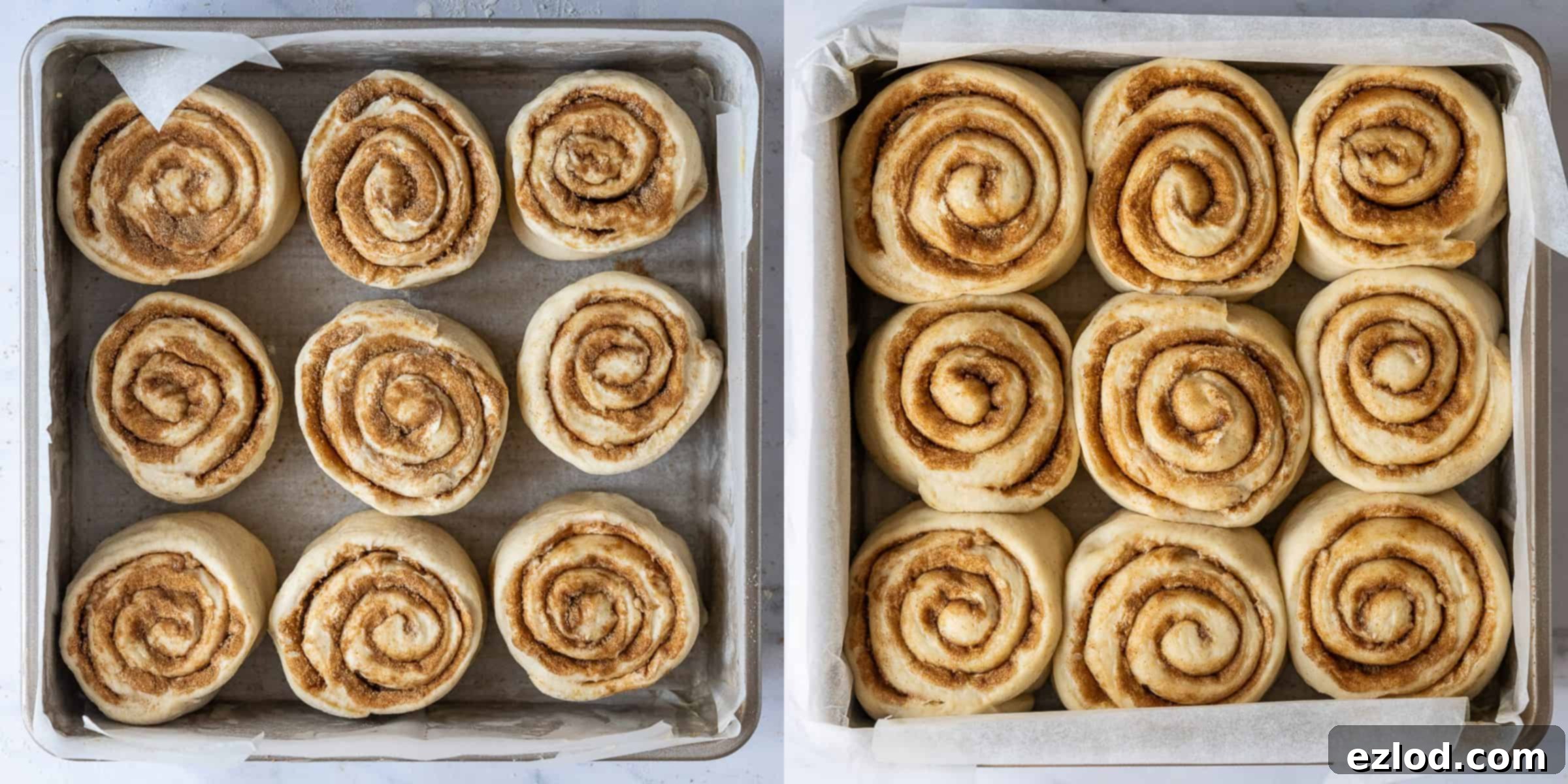
Glazing and Serving:
- Let the baked cinnamon rolls cool slightly in the tin. For the glaze, sift the icing (powdered) sugar into a bowl. Stir in the melted vegan butter, vanilla extract, and non-dairy milk until you achieve a thick but pourable consistency. Add a tiny bit more milk if needed to reach your desired texture.
- Drizzle the luscious glaze generously over the warm cinnamon rolls and serve immediately. They are truly best enjoyed on the day they are baked for maximum freshness and softness.
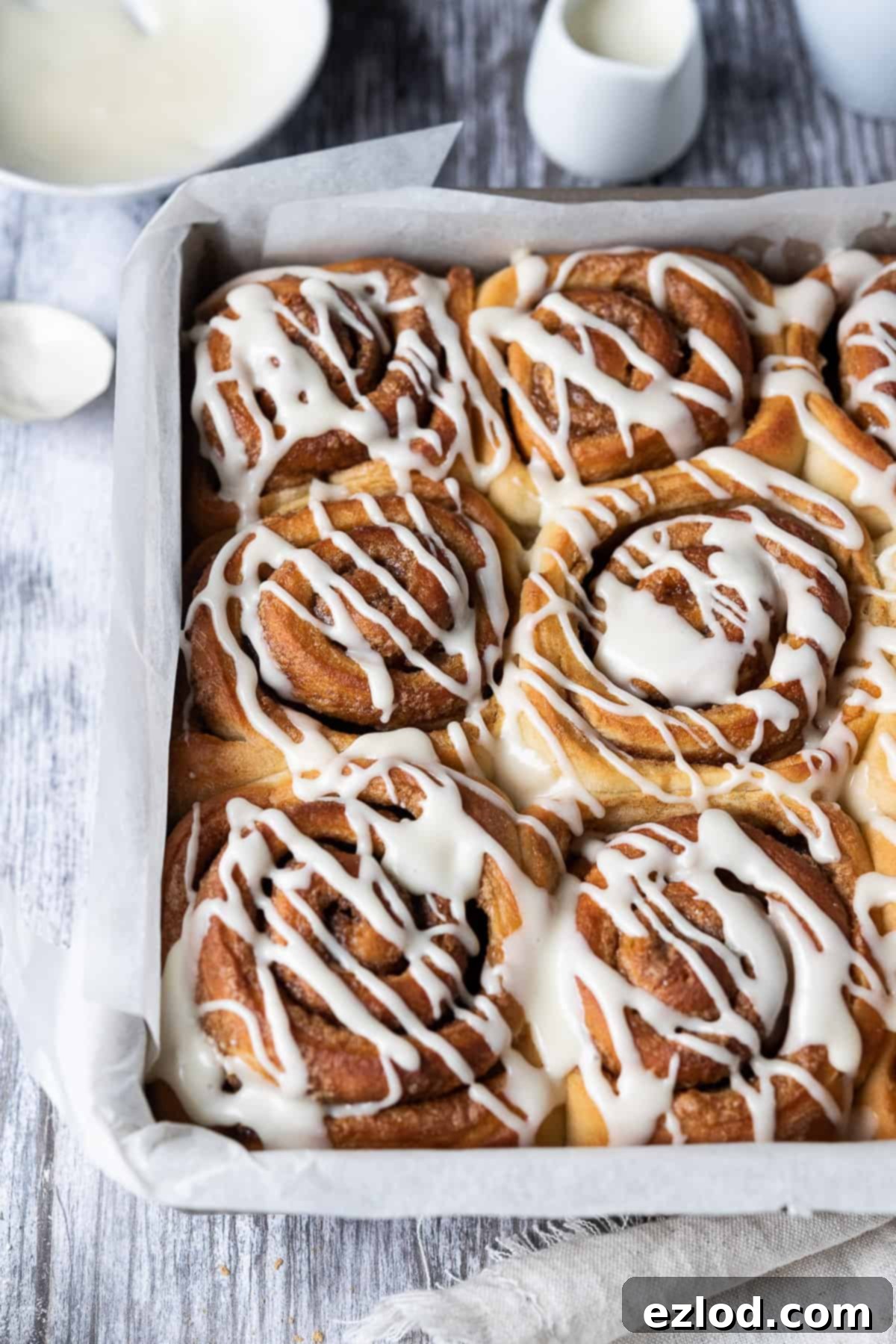
Frequently Asked Questions About Vegan Cinnamon Rolls
Can I Freeze These Vegan Cinnamon Rolls?
Absolutely! These delicious vegan cinnamon rolls can be frozen once they have completely cooled after baking. For optimal freshness, freeze them on the same day they are baked. Store them in an airtight container or wrap them thoroughly in the pan with plastic wrap and then foil to prevent freezer burn. To serve, allow them to thaw at room temperature, then refresh them in a low oven (around 160°C/325°F) for 5-10 minutes, or microwave individual rolls for 10-20 seconds until warmed through. I do not recommend freezing the unbaked dough.
What Kind Of Yeast Should I Use?
I typically use instant yeast, which is incredibly convenient as it can be added directly to your dry ingredients without needing to be proofed first. However, if you only have active dry yeast, you can still make these rolls with a slight modification to the method.
If using active dry yeast (you’ll need about 10g or 3 teaspoons), prepare the Tangzhong as instructed, then transfer it to a bowl and cover it directly with cling film or parchment paper to prevent a skin from forming. Allow it to cool completely to room temperature. Instead of cold milk for the dough, use lukewarm non-dairy milk (not hot, as heat will kill the yeast – it should feel comfortably warm to the touch). Mix the active dry yeast with the lukewarm milk and a pinch of sugar, then let it sit for 10-20 minutes until it becomes frothy and bubbly. This indicates the yeast is active. Once bubbly, proceed with the rest of the recipe.
How Can I Speed Up The Rising Time?
Yeast doughs love warmth! If your kitchen is on the cooler side and you want to accelerate the rising process, here are a few tricks:
- Warm Oven Method: Briefly preheat your oven to its lowest setting for a couple of minutes, then switch it off. Open the oven door for about 30 seconds to let out some of the intense heat. Test the temperature with your hand – it should feel warm, like a pleasant summer day, not hot. Place the covered dough in the warmed oven and close the door. On very cold days, you might need to re-warm the oven once more after an hour, but usually, one warming is sufficient.
- Steam Method: Place a bowl or loaf tin filled with boiling water on the bottom rack of your (cold, switched off) oven. Position your covered dough on the middle shelf above the water. Close the oven door. The steam from the hot water will create a warm, humid environment, ideal for yeast to thrive and the dough to rise quickly.
Can I Bake These Vegan Cinnamon Rolls In Advance?
While these vegan cinnamon rolls are truly at their peak on the day they’re baked, the Tangzhong method helps them retain their softness for a couple of days. You have a couple of options if you wish to prepare them in advance:
- Overnight Dough Rise: Make the dough in the evening and let it perform its first rise overnight in the refrigerator. The next morning, you can continue with shaping, the second rise, and baking.
- Bake and Reheat: Bake the cinnamon rolls the evening before you plan to serve them, but omit the glaze. Allow them to cool completely in the pan, then cover them tightly. The following day, tent the pan with aluminum foil and reheat in an oven preheated to 180°C/160°C fan/350°F/gas mark 4 for about 5-10 minutes, or until warmed through. Then, prepare and add the fresh glaze before serving. Individual rolls can also be warmed in the microwave for a few seconds.
What Size Baking Tin Should I Use?
I typically use a 23 cm (9-inch) square baking tin, which yields 9 wonderfully large and indulgent vegan cinnamon rolls. If you prefer to make 12 slightly smaller rolls, an approximate 20 x 30 cm (8 x 12 inch) rectangular tin will work perfectly. Do note that if you opt for 12 smaller rolls, their baking time might be shorter, likely around 20-25 minutes instead of the 30-35 minutes required for the larger 9-roll batch.
How To Tell When Cinnamon Rolls Are Properly Baked:
The most reliable way to ensure your bread is perfectly baked is by checking its internal temperature with a probe thermometer. The center of a properly baked cinnamon roll should register at least 90°C (194°F). Overbaked rolls will be dry and tough, while underbaked ones will have an unpleasant raw doughy center. Since all ovens vary and appearances can be deceiving (a beautifully browned exterior doesn’t guarantee a cooked interior), a thermometer is an invaluable kitchen tool. If you don’t have one, a thin toothpick inserted into the center of the middle roll should come out clean with little resistance.
Can I Knead The Dough By Hand?
This Tangzhong dough is designed to be quite soft and sticky, which makes a stand mixer with a dough hook the easiest way to knead it. However, if you don’t have a stand mixer, you absolutely can knead the dough by hand! Just be prepared for a bit of a workout and a slightly sticky experience. Avoid the temptation to continually add flour to your work surface, as this can make the dough too dry and compromise the final texture. Instead, lightly oil your hands and the work surface if the dough becomes too sticky to manage. A bench scraper can be incredibly helpful for scraping the dough off the surface and folding it during hand kneading.
Can I Make Them Gluten-Free?
Unfortunately, this particular recipe is not suitable for gluten-free flour. Adapting bread recipes, especially those relying on gluten development like Tangzhong, to be gluten-free requires significant reformulation and specialized ingredients. Gluten-free baking is a unique area of expertise, and as this recipe is developed for gluten-containing flours, I cannot provide advice on how to convert it to a gluten-free version.
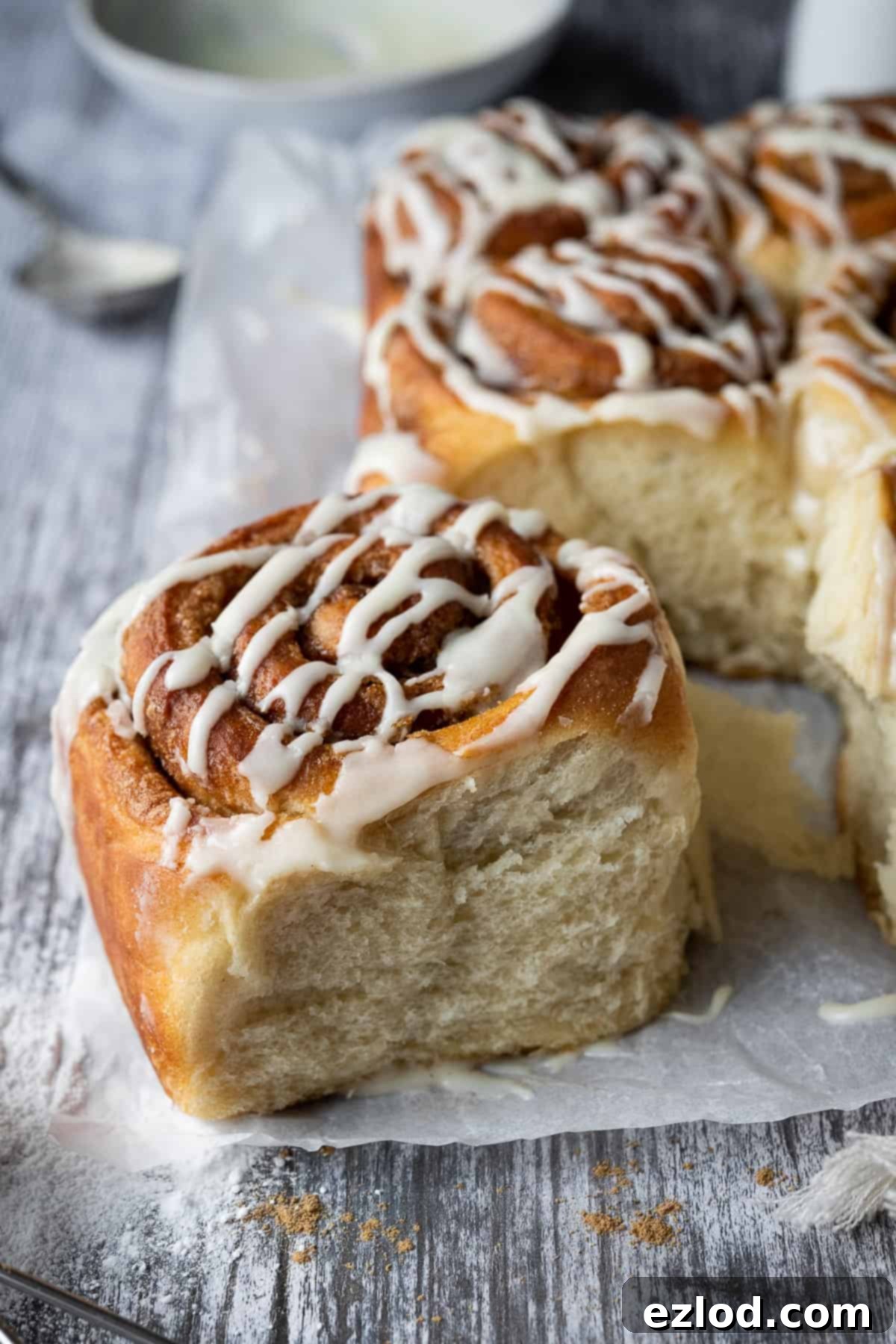
Top Tips for Perfect Vegan Cinnamon Rolls
- Precision is Key: For the best and most consistent results, always follow the recipe instructions carefully. I highly recommend using a digital scale to measure ingredients in grams rather than relying on cup conversions. Cup measurements can be inconsistent and may lead to varied outcomes in baking.
- Check Your Yeast: Ensure your instant yeast is fresh and not expired. Outdated yeast will lose its leavening power, leading to rolls that don’t rise properly.
- Resist Adding More Flour: The dough for these cinnamon rolls is intentionally soft and a little sticky. It’s crucial not to add too much extra flour during kneading or rolling, as this will result in dry, dense, and less fluffy rolls.
- Adjust Rising Times: The time it takes for dough to rise can vary significantly based on your kitchen’s ambient temperature. On warmer days, the dough will prove much faster than on cooler days. Always go by visual cues (doubled in size, puffy) rather than strict time limits.
- Flour Choice Matters: While bread flour yields the best chewy-soft texture, you can substitute it with plain (all-purpose) flour if necessary. However, for a truly exceptional result, stick with bread flour. Avoid wholemeal/whole wheat flour, as it will make the rolls heavy and dense.
- Customize Your Filling: Feel free to get creative with the filling! You can add finely chopped nuts, dried fruit like raisins or cranberries, or even some vegan chocolate chips for an extra layer of flavor and texture.
- Overnight Rise for Flavor: For convenience and enhanced flavor, consider preparing the dough the evening before you plan to bake. Letting it rise slowly overnight in the refrigerator not only deepens the taste but also makes the chilled dough easier to roll out.
- Enjoy Fresh: These vegan cinnamon rolls are most glorious when eaten on the day they are baked. However, thanks to the Tangzhong method, they remain wonderfully soft for a couple of days. A quick warm-up in the oven or microwave before serving will bring them back to life.
Why Is This Post So Detailed?
I understand that sometimes you just want to jump straight to the recipe! However, my goal is to equip you with all the knowledge and tips necessary to successfully bake these incredible vegan cinnamon rolls. Bread baking, while rewarding, can sometimes be a bit finicky. By providing comprehensive details on ingredients, techniques, and troubleshooting, I aim to minimize any potential user errors and answer common questions you might have before they even arise. Think of this as your complete guide to achieving bakery-quality vegan cinnamon rolls at home!
If you’ve taken the time to read through the post, many of your questions might already be answered. If not, please feel free to leave a comment below, and I’ll do my best to assist you.
Explore More Vegan Cinnamon Roll Recipes:
If you loved these classic vegan cinnamon rolls, you might enjoy trying some of my other creative variations:
- Vegan Pumpkin Cinnamon Rolls
- Gingerbread Cinnamon Rolls
- Banana Bread Cinnamon Rolls
- Vegan Lemon Blueberry Rolls
- Vegan Wholemeal Maple Cinnamon Rolls
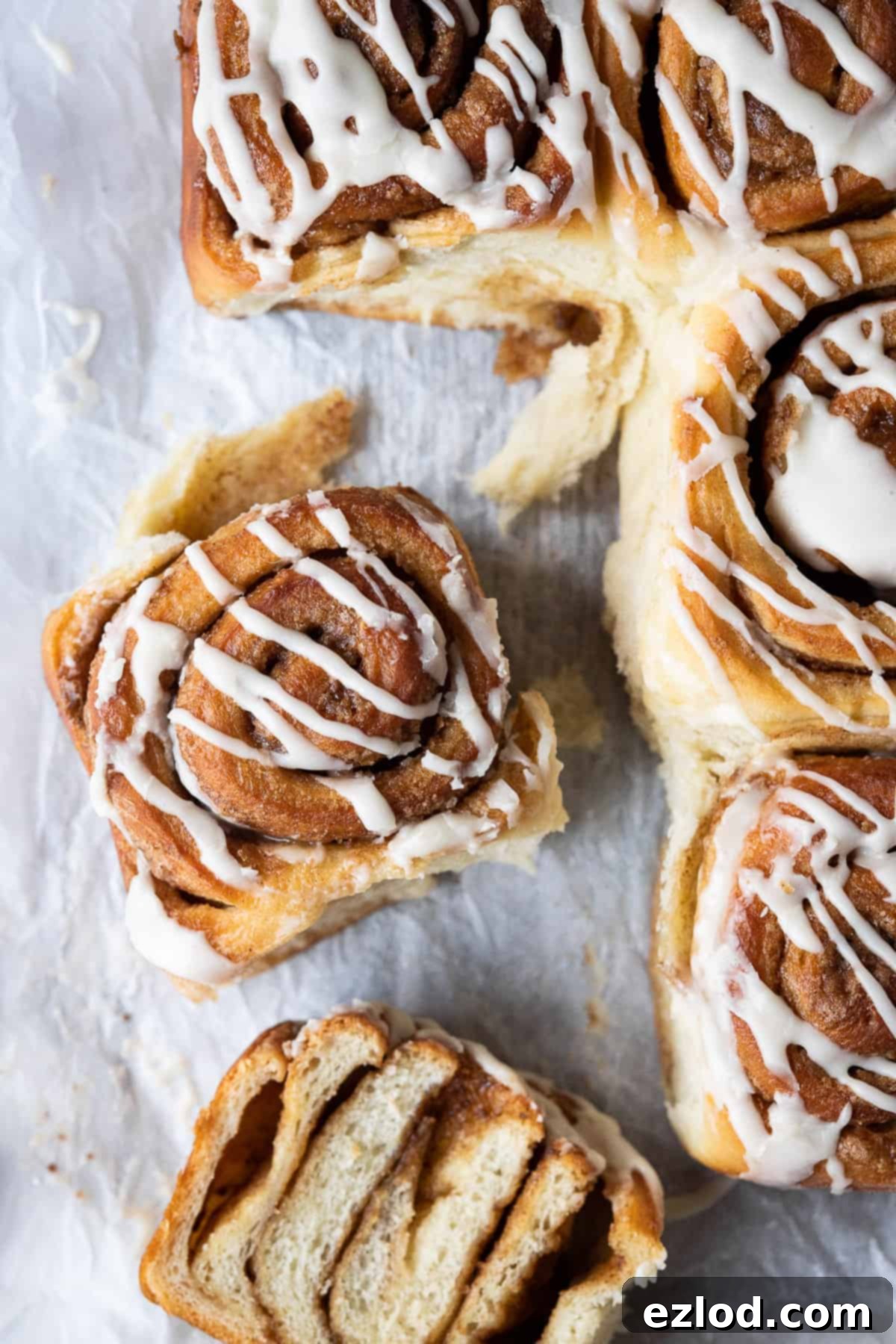
If you tried this recipe and loved it, please let me know your thoughts! Rate it, leave a comment below, or tag @domestic_gothess on Instagram with the hashtag #domesticgothess. Your feedback means a lot!
*All images and content on Domestic Gothess are copyright protected. If you wish to share this recipe, please use the provided share buttons. Do not screenshot or post the full recipe or content.*

Vegan Cinnamon Rolls
Ingredients
Tangzhong:
- 30 g (¼ cup) white bread flour
- 160 ml (⅔ cup) unsweetened non-dairy milk (soy is best)
Dough:
- 180 ml (¾ cup) cold unsweetened non-dairy milk (soy is best)
- 50 g (¼ cup) caster or granulated sugar
- 1 tsp salt
- 400 g (3 ¼ cups) white bread flour
- 8 g (2 ½ tsp) instant yeast
- 60 g (¼ cup) vegan block butter, softened (Naturli Vegan Block recommended)
Filling:
- 120 g (½ cup + 1 Tbsp) light brown soft sugar
- 15 g (1 ½ Tbsp) cornflour (cornstarch)
- 1 ½ Tbsp ground cinnamon
- ⅛ tsp salt
- 80 g (¼ cup + 2 Tbsp) vegan block butter, very soft
Glaze:
- 120 g (1 cup) icing (powdered) sugar
- 15 g (1 Tbsp) vegan butter, melted
- ½ tsp vanilla extract
- 1 Tbsp non-dairy milk
Instructions
-
I like to split making these over two days – I make the dough and refrigerate it overnight for its first rise. The cold dough is easier to roll out and the slow rise results in a better flavor. You can do it all on the same day if you prefer though.
-
To make the Tangzhong, place the flour in a saucepan and gradually whisk in the milk to avoid lumps.
-
Place the pan over a medium/low heat and whisk constantly until the mixture has thickened to a paste/pudding-like consistency (think wallpaper paste…).
-
Scrape the Tangzhong into the bowl of a stand mixer fitted with a dough hook and pour the rest of the cold milk on top. This will cool the Tangzhong down so that it doesn’t kill the yeast.
-
Add the sugar, salt and flour and finally the yeast. Stir until it forms a rough dough then set the stand mixer to a medium speed and mix until the dough is smooth and stretchy, this can take about 10 minutes.
-
Add the softened vegan butter and knead for about another 5 minutes until it is fully incorporated and the dough is smooth, elastic and no longer feels greasy. You may need to scrape down the sides of the bowl a couple of times.
-
The dough should still be soft and sticky, but it should pull away from the sides of the bowl cleanly. If it seems too wet then you can knead in a little extra flour, a tablespoon at a time. Be careful though, this is meant to be a soft dough and adding too much extra flour will make the cinnamon rolls dry.
-
Place the dough in a lightly oiled bowl, cover and place in the fridge to rise overnight, or in a warm spot for 1-2 hours, until doubled in size.
-
For the filling, mix together the light brown soft sugar, cinnamon, cornflour (cornstarch) and salt in a bowl and set aside.
-
The following day (or once the dough has doubled in size at room temperature), knock back the dough and give it a brief 30 second knead to knock out the air bubbles.
-
Roll the dough out on a floured surface to an approx 30 x 45 cm / 12 x 18 inch rectangle. Try and keep it rectangular rather than oval so that your cinnamon rolls end up more evenly sized.
-
Spread the soft vegan butter evenly over the surface, leaving about a 1cm border around the edge. If the butter is too cold it will be hard to spread without distorting the dough so make sure that it is really soft, but not melted. I use my hands to spread it over the dough.
-
Scatter over the cinnamon sugar mixture and press it down gently. You can do this with your hands or a rolling pin.
-
Roll the dough up from one of the long sides into a sausage. Slice the roll into 9 even pieces (or 12).
-
The best way to get a clean cut is to place a piece of unflavoured dental floss under the sausage where you want to make the cut, cross the ends of the floss over each other and pull. Otherwise you can use a very sharp knife to slice it.
-
Arrange the rolls in a 23cm/9in square cake tin lined with baking parchment (or a 20 x 30 cm / 8 x 12 in one if you are making 12 rolls).
-
Cover loosely and set aside to rise for about 45-60 minutes until they are nice and puffy. If you press one gently the dough should spring back slowly. If it springs back quickly then they need a little bit longer. While they are rising preheat the oven to 180°C/160°C fan/350°F/gas mark 4.
-
Once the buns have risen, bake for 30-35 minutes (more like 20-25 minutes if you are making 12 rather than 9 rolls), until the internal temperature reaches 90°C/194°F on a probe thermometer.* Cover them loosely with tin foil partway through baking if the tops start to colour too much.
-
Leave the cinnamon rolls to cool in the tin. To make the glaze, sift the icing sugar into a bowl and stir in the melted butter, vanilla and milk to form a thick but pourable glaze. You can add a drop more milk if needed.
-
Drizzle the glaze over the rolls and serve. Best eaten on the day they are baked.
Notes
- For the best results, make sure that you follow the recipe closely. As always, I highly recommend weighing your ingredients using the gram measurements (with a digital scale), rather than the cup conversions. Cup measurements are simply not accurate enough for baking and I cannot guarantee the best results if you use them. A gram is always a gram, but a cup won’t always measure out the same amount.
- Make sure that you read the entire post for all of the tips and FAQs before starting with the recipe.
- *If you don’t have a thermometer, then a toothpick inserted into the centre of the middle cinnamon roll should go in and out smoothly with little resistance and come out clean.
